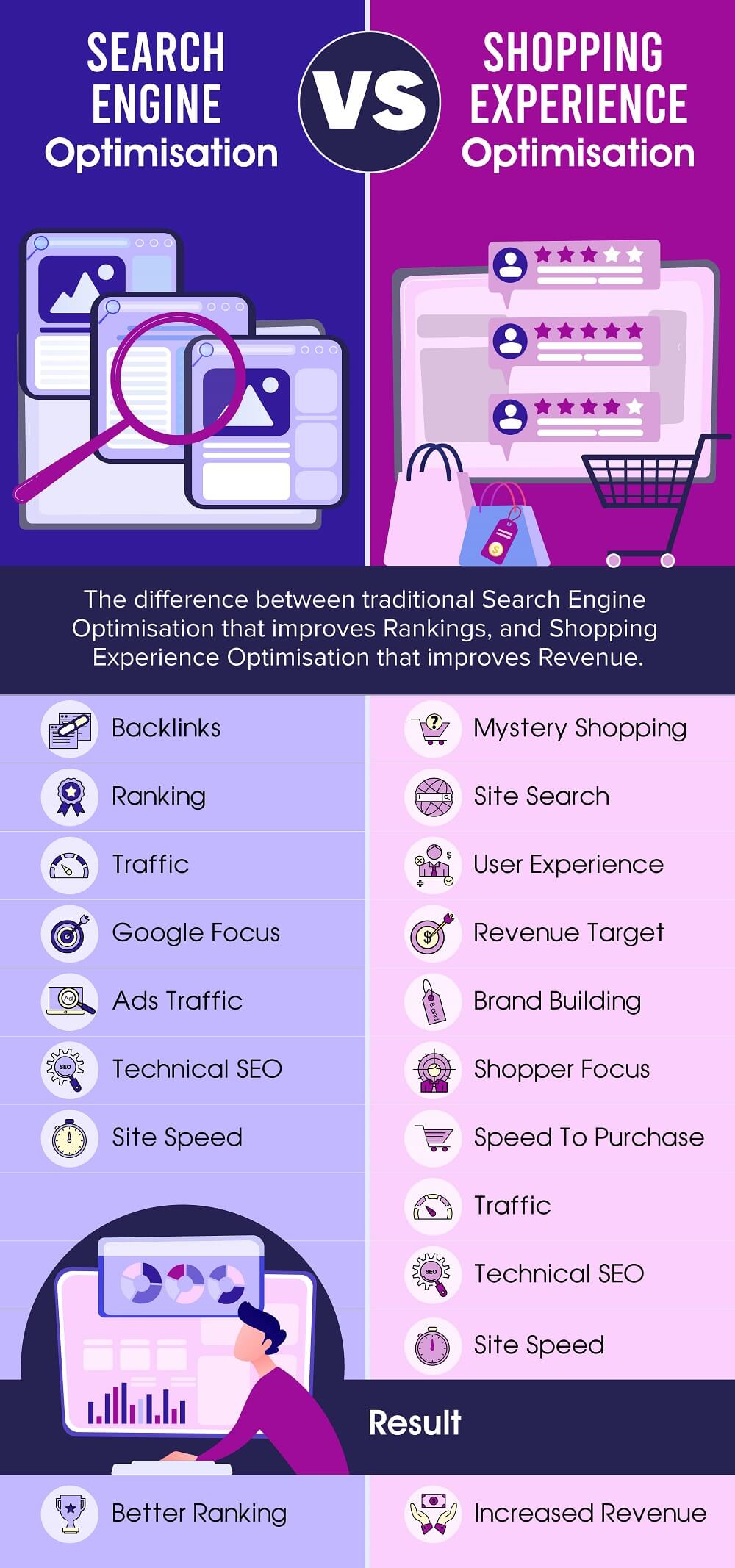Shopping Experience Optimisation
I think it’s time to redefine SEO. For us it is anyway…
Search engine optimisation has never really been a thing, unless you own a search engine. You might do search engine optimisation if you work at Google but if you’re not actually working at a search engine you can’t optimise any part of it.
Basically search engine optimisation is just a euphemism for search engine manipulation.
And certainly that’s what we (and the majority of the industry) did for the first 15 years of our existence. Over the last five or six years though we’ve been working very differently in the way that we approach Google and the traffic that we get from it.
Search engines don’t buy your products; people do!
SEO Past
Pre-Google it was child’s play to manipulate the search results. It was simply a technique called “keyword stuffing”. This technique involved placing keywords on pages where humans couldn’t see them but search engines could and consequently they would rank our pages mostly on keyword density. Very soon our industry made search engines of the time unusable due to the vast amounts of spammy results.
When Google came along it was harder to manipulate. It gave better results than the other search engines as instead of just looking at the ratio of keywords on the page, Google looked at what other pages were linking to yours and counted those links as a vote for your page. The following day we started doing backlinking campaigns. From about 2003 – 2009 you could rank fairly easily with some relevant content and a bunch of backlinks.
A major change to the Google algorithm happened in 2009. It was called the Vince update and overnight lots of brands went to number one in the search results above our clients. Prior to this we were pretty confident we could rank higher than major brands with some simple tricks and not much effort. That began to change after the Vince update.
Our industry assumed that overnight Google had somehow just favoured brands in organic search. Google stated that the Vince update was about rewarding content that was more “trustworthy”. So it seemed the algorithm classified a strong brand as a trust signal.
At the same time Google Ads products started to get better and better. This of course is the real reason for Google’s existence. It’s how they keep their shareholders happy.
And with the advent of smartphones in 2008 everything began to change. Soon Google had mobile friendly search results and gradually the number of ads in the results began to increase making it harder to tell the difference between a paid result and an organic one.

SEO Future
The measure of success under the previous definition of SEO was appearing at least in the top three positions of a search results page. It was evident to many eCommerce businesses that rankings don’t equate to revenue, and it’s revenue that helps a business survive.
Therefore we shifted our SEO approach to one that focussed on the true benchmark of a website; how customer friendly it was. It was this pivot from trying to appease a search engine to one that satisfied the needs of a customer that the evolution was complete.
Shopping Experience Optimisation was born.
While the foundations of digital marketing remain, the efforts of our team are now directed at analysing and identifying missed revenue opportunities for your business. Using a combination of Mystery Shopping, Brand strengthening, and a Shopper focus, we create a custom roadmap that sets agreed revenue goals based on ads returns and technical site improvements.
Our new world has seen exponential growth in eCommerce, and while some of the heat may eventually reduce some of that growth there is no doubt that eCommerce has accelerated faster than anyone could have predicted. Therefore we decided to evolve SEO and focus on the shopper and their demands in this new eCommerce world. Some of the features of our Shopping Experience Optimisation include the following:
- Mystery Shopping – When was the last time you browsed your store? When was the last time you bought something from your store on mobile? You’d be surprised how little time store owners spend on their own site. We offer a comprehensive Mystery Shopping service that has been carefully formulated to deep-dive your entire shopping experience and reveal the roadblocks and revenue opportunities.
- Shopper Focus – For too long eCommerce owners have reached for the supposed Holy Grail; number one on Google! But appeasing search engines won’t put money in your pocket. Our Shopping Experience Optimisation focuses on the shopper, anticipating their needs, removing their annoyances, and making it as easy as possible for the money to move from their (virtual) hand into your bank account.
- Site Search – Wandering aimlessly through a store is fun if you’re into that sort of thing. We’re not. Our data shows customers want speed to purchase, meaning they get their product and you get their money in the shortest possible time. A store greeter is ideal in a physical store and site search is the digital equivalent. We’ll help you optimise it.
- Revenue Targets – Our SEO places revenue over rankings. After all, revenue pays the bills. With the help of our site analysis and custom designed digital strategy we will agree on set revenue targets, ones that you can look forward to and track the progress of over coming months.
Now more than ever it’s imperative your eCommerce business is user friendly. After all, you need to ask who your customer is. A search engine or a person?
Shopping Experience Optimisation.
SEO redefined.

Get in touch today and we can begin planning how, together, we’ll take your business to the next level
